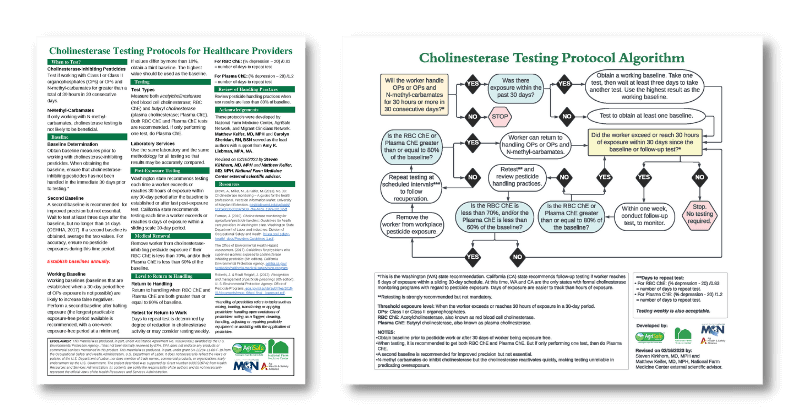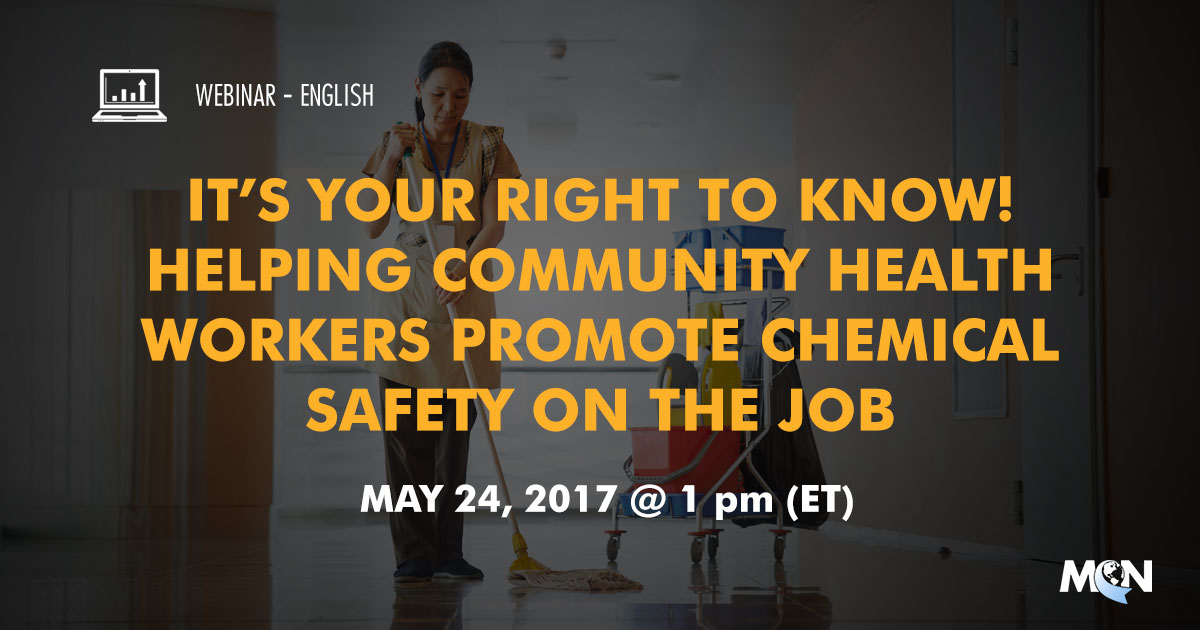
These Cholinesterase (ChE) clinical tools provide a concise and simple format to guide clinicians in monitoring the ChE levels for patients working with Class I and Class II organophosphates (OP) or OP and N-methyl-carbamates.

These Cholinesterase (ChE) clinical tools provide a concise and simple format to guide clinicians in monitoring the ChE levels for patients working with Class I and Class II organophosphates (OP) or OP and N-methyl-carbamates.
This guide is intended to support new and existing community health center program grantees in the State of California to successfully navigate through their unique and complex environment, particularly in regards to financial and operational processes at both the state and federal levels. Offered for free on the California Primary Care Association Store.
"HITEQ developed a series of eLearning modules for new staff that focus on Health IT and the Triple Aim, but provide a good deal of health center context as well:"

DATE: May 24, 2017, 1 pm (ET)
SPEAKERS: Juliana Simmons, MSPH, CHES
To receive CME* or CNE credit after viewing this webinar, you must:
José Navarro was excited for his new career after landing a job in the poultry industry. After five years on the job, 37 year-old Navarro began coughing up blood. He died soon after when his lungs and kidneys failed. His death triggered a federal investigation raising questions about the health risks associated with the use of toxic chemicals in poultry plants.
Millions of workers are exposed to chemicals everyday on the job. All workers have the right to know about the chemicals they work with and community health workers can be an important source of information and support for workers. This workshop will teach community health workers how to explain what happens when someone is exposed to chemicals and how workers can best protect themselves
This project is supported by the Health Resources and Services Administration (HRSA) of the U.S. Department of Health and Human Services (HHS) under cooperative agreement number U30CS09742, Technical Assistance to Community and Migrant Health Centers and Homeless for $1,094,709.00 with 0% of the total NCA project financed with non-federal sources. This information or content and conclusions are those of the author and should not be construed as the official position or policy of, nor should any endorsements be inferred by HRSA, HHS or the U.S. Government.

FECHA DE GRABACION: 5 de Abril de 2017, 1 pm ET (zona horaria del Este)
ORADORA: Ileana Ponce-González, MD, MPH, CNC
Para recibir credito de Trabajador/a de Salud Comunitaria o Educacion de Continua de Enfermera después de ver alguno de estos seminarios usted debe hacer lo siguiente:
En este webinar, los participantes podrán identificar las medidas de desempeño de la Administración de Servicios de Recursos de Salud relacionadas con la hipertensión, describir cómo medir la hipertensión en el cuerpo, entender cómo alentar a los pacientes a controlar y manejar su presión arterial alta y entender las principales barreras que enfrentan pacientes en el control y manejo de su presión arterial alta.
Este proyecto cuenta con el apoyo de la Administración de Recursos y Servicios de Salud (HRSA) del Departamento de Salud y Servicios Humanos de los Estados Unidos bajo el acuerdo de cooperación número U30CS09742, Asistencia Técnica a Centros de Salud Comunitarios y Migrantes y Personas sin Hogar por $ 1,094,709.00 con 0% del total Proyecto NCA financiado con fuentes no federales. Esta información o contenido y las conclusiones son las del autor y no deben ser interpretadas como la posición o política oficial de, ni cualquier endosos deben ser inferidos por HRSA, HHS o el Gobierno de los Estados Unidos.
Includes EPA manual "How to Comply With the 2015 Revised Worker Protection Standard For Agricultural Pesticides - What Owners and Employers Need To Know" and an excerpt specifically for clininicians regarding medical evaluation and respirator fit test. See also the medical evaluation questions in English and Spanish.
The U.S. Environmental Protection Agency’s (EPA) Worker Protection Standard (WPS) provides basic workplace protections to farmworkers and pesticide handlers to minimize the adverse effects of pesticide exposure. EPA announced major revisions to the WPS in September 2015. MCN and FJ's fact sheet provides a summary of the revised regulation.
For the first time, the U.S. Preventive Services Task Force has released an e-book version of its Guide to Clinical Preventive Services. The e-book is compatible with many readers, including Kindle, Nook, iBook, and Kobo. The new “Guide to Clinical Preventive Services, 2014” is a comprehensive resource that can help primary care clinicians and patients decide together which preventive services are right for a patient’s needs. It includes all active Task Force evidence-based recommendations since 2004, including 28 new and updated recommendations since the 2012 guide, in a format meant for use at the point of patient care. It also includes information about topics in development, clinical summary tables and additional resources.
Summary of Results from the California Pesticide Illness Surveillance Program - 2010.
The Department of Pesticide Regulation administers the California pesticide safety program, widely regarded as the most stringent in the nation. Mandatory reporting of pesticide illnesses has been part of this comprehensive program since 1971. Illness reports are collected, evaluated and analyzed by program staff. PISP is the oldest and largest program of its kind in the nation; its scientists provide data to regulators, advocates, industry, and indivudal citizens.
This is the first of several resources MCN is developing to aid health centers in addressing the unique healthcare needs of migrant patients within the Patient Centered Medical Home. In addition, MCN is developing tools and resources health centers can utilize as they seek PCMH recognition.
Open Access means that patients can get same-day appointments for acute care needs and rapid access to routine care needs. This resource describes what Open Access looks like for migrant patients.
NCQA Standard 1: Enhance Access and Continuity; Element A: Access During Office Hours

These Cholinesterase (ChE) clinical tools provide a concise and simple format to guide clinicians in monitoring the ChE levels for patients working with Class I and Class II organophosphates (OP) or OP and N-methyl-carbamates.
This booklet is intended to help Community Health Centers put in place an effective and efficient workers' compensation program.